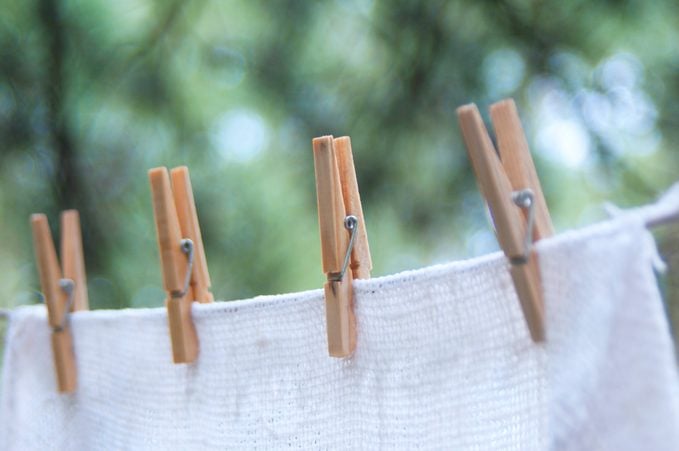Can You Wash ‘Dry Clean Only’ Clothes at Home?
Updated: Nov. 06, 2023
It's late, your suit is dirty but you need it for tomorrow's meeting. Here's how to dry clean clothes at home.
Lugging your clothes to the dry cleaner every month (or week) can be a pain. There are only so many times you can re-wear a shirt before it starts to smell. Plus, dry cleaning can get expensive. If you’re up for the challenge and trust yourself to wash some of your higher-end clothing items on your own, then dry cleaning at home will be a breeze.
Fashion stylist Cindy Conroy shared some tips on how to wash “dry clean only” clothes at home. Her first bit of advice?
“Depending on the fabric, some clothes labeled ‘dry-clean only’ can be washed at home — whether you put it in the washing machine or hand wash it,” said Conroy. “All you need to do is be careful.”
On This Page
Washing Your ‘Dry Clean Only’ Clothes At Home
- First, Conroy recommends starting with something easy, especially if you’ve never tried to dry clean at home before. Ease your way in with a dress shirt or polyester pants before trying an expensive suit.
- If you’re too anxious to try using your washing machine, wash your clothes in your sink using a laundry bar.
- To start hand washing, fill the sink (or tub if you have a lot of clothes) with cold water and place your clothes in (sort them first!). Rub your laundry bar on a few pieces of clothes so suds appear in the water and the clothes can soak. Take out one item of clothing at a time and rub the problem areas with your laundry bar; pay extra attention to areas where you sweat such as the armpits and collar. When you’re done scrubbing, let it soak while you tackle another piece. When you’re finished, rinse all your clothes in cold water until there’s no more soap.
- If you’re feeling brave enough to use the washing machine, make sure to separate your darks, colors and whites before starting the load so colors don’t bleed on each other. “If you have a dress, shirt or pants that have specks of color, err on the side of caution and wash those separately from your other items,” says Conroy.
- Wash your “dry clean only” clothes in cold water with a gentle yet heavy-duty detergent. Conroy recommends Woolite Darks or Woolite Color Renew. This will keep your clothes looking like new and prevent them from being stretched out.
- If you have cashmere or wool clothing items to dry clean at home, Conroy recommends a wool and cashmere shampoo. If you don’t have that on hand, Conroy says that your laundry bar will also work. “Hand wash and spot clean where needed before hanging flat to air dry on a rack,” says Conroy. “When the item is three-quarters of the way dry, transfer it to a coated metal or plastic hanger that won’t pierce the fabric and cause it to dry into a stiff-awkward form (like hanger indents in the sleeves).”
Treating Bad Stains and Odors
If the clothes you’re attempting to dry clean at home have a bad stain or odor, you’ll need to break out the vinegar.
“Bacteria trapped in the fibers of the clothing causes discoloration and/or odor,” says Conroy. “Soaking an item in half a cup of vinegar and cold water for 30 minutes preps it.”
After the stain has been prepped, gently rub the area with your fingers to break up the fibers. If the stain won’t budge, turn the clothing item inside out and apply a small amount of vinegar directly to the area. Then wash normally using the steps laid out above and you’ll have clean clothes in no time.
Another great stain remover is baking soda. Mix four tablespoons of baking soda and a 1/4 cup of warm water to make a paste. Apply it to the stain and let it sit for one to two hours before washing.
Drying Your Clothes

Never put your “dry clean only clothes” in the dryer. It may seem harmless, but it can ruin your nice clothing items.
“Hang your items somewhere in your home,” Conroy says. “It can be on hangers dangling over your tub, on doorknobs or a clothing rack. But don’t let them dry completely. You want them to be damp to the touch, not sopping wet. When they are, they’re ready to be steamed. If you don’t have a steamer at home, you can use an iron, but you’ll only get that professional dry cleaned look with a steamer. So it’s worth the investment.”
When you’re steaming, make sure you aren’t too close to the fabric, just close enough that the steam is dissolving the creases.